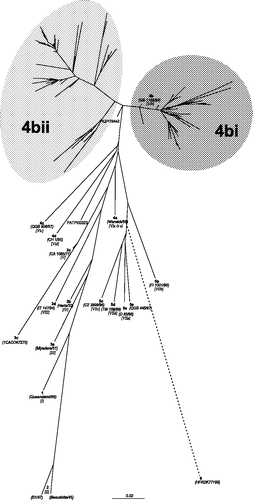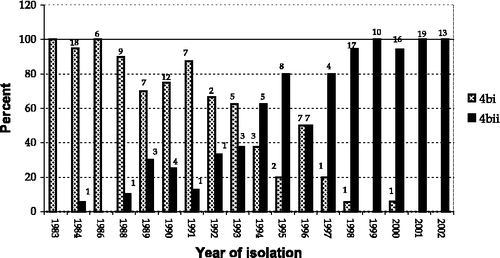Figures & data
Table 1. Details of ND (APMV-1) viruses analysed in this study
Figure 1. Unrooted maximum likelihood radial phylogram based on nucleotide sequence data from 225 APMV-1 isolates, including 208 PPMV-1 isolates and 17 representative of the other genetic lineages (Aldous et al., Citation2003). The region analysed was a 375 base pair fragment (47 to 422) at the 3′ end of the fusion protein gene. Branch lengths represent the predicted number of substitutions and are proportional to the differences between the isolates. The individual names of each PPMV-1 isolate included in this phylogram are not included. The groups selected for this study are shaded on the tree and labelled. The branch to isolate HFRDK77188 (group 6) is not drawn to scale; its actual branch length value is 1.66.

Figure 2. Unrooted maximum likelihood radial phylogram of subgroup 4bi isolates, based on nucleotide sequence data from 91 PPMV-1 isolates. The region analysed was a 375 base pair fragment (47 to 422) at the 3′ end of the fusion protein gene. Branch lengths represent the predicted number of substitutions and are proportional to the differences between the isolates. * Isolates represent at least one other identical sequence as presented in .

Figure 3. Unrooted maximum likelihood radial phylogram of subgroup 4bii isolates, based on nucleotide sequence data from 114 PPMV-1 isolates. The region analysed was a 375 base pair fragment (47 to 422) at the 3′ end of the fusion protein gene. Branch lengths represent the predicted number of substitutions and are proportional to the differences between the isolates. * Isolates represent at least one other identical sequence as presented in .

Table 2. Isolates included in and (marked *) that represent other isolates with identical sequences
Figure 4. Percentage distribution of isolates in group 4bi and group 4bii according to year of isolation (data label is actual number of isolations).
